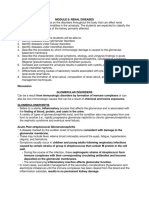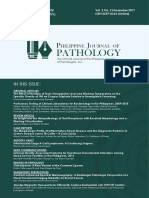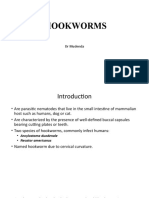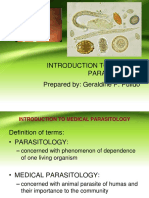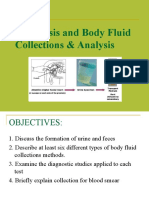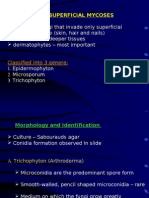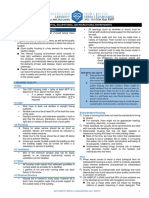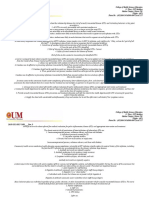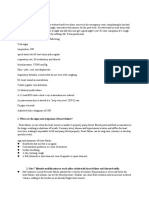0 ratings0% found this document useful (0 votes)
166 viewsAUBF Lec - Lab Safety - QA
AUBF Lec - Lab Safety - QA
Uploaded by
Leinard ClaveroThis document discusses laboratory safety hazards and biological hazards. It describes the chain of infection, which explains how microorganisms are transmitted between a source, reservoir, exit portal, transmission means, entry portal, and susceptible host. Breaking the chain of infection is important for preventing the spread of disease. Standard precautions like hand hygiene, personal protective equipment, proper waste disposal and decontamination help control infections in the laboratory setting by preventing contact between infectious agents and susceptible hosts.
Copyright:
© All Rights Reserved
Available Formats
Download as PDF, TXT or read online from Scribd
AUBF Lec - Lab Safety - QA
AUBF Lec - Lab Safety - QA
Uploaded by
Leinard Clavero0 ratings0% found this document useful (0 votes)
166 views12 pagesThis document discusses laboratory safety hazards and biological hazards. It describes the chain of infection, which explains how microorganisms are transmitted between a source, reservoir, exit portal, transmission means, entry portal, and susceptible host. Breaking the chain of infection is important for preventing the spread of disease. Standard precautions like hand hygiene, personal protective equipment, proper waste disposal and decontamination help control infections in the laboratory setting by preventing contact between infectious agents and susceptible hosts.
Original Description:
Transes for 3rd year student for aubf
Original Title
AUBF Lec- Lab Safety _ QA
Copyright
© © All Rights Reserved
Available Formats
PDF, TXT or read online from Scribd
Share this document
Did you find this document useful?
Is this content inappropriate?
This document discusses laboratory safety hazards and biological hazards. It describes the chain of infection, which explains how microorganisms are transmitted between a source, reservoir, exit portal, transmission means, entry portal, and susceptible host. Breaking the chain of infection is important for preventing the spread of disease. Standard precautions like hand hygiene, personal protective equipment, proper waste disposal and decontamination help control infections in the laboratory setting by preventing contact between infectious agents and susceptible hosts.
Copyright:
© All Rights Reserved
Available Formats
Download as PDF, TXT or read online from Scribd
Download as pdf or txt
0 ratings0% found this document useful (0 votes)
166 views12 pagesAUBF Lec - Lab Safety - QA
AUBF Lec - Lab Safety - QA
Uploaded by
Leinard ClaveroThis document discusses laboratory safety hazards and biological hazards. It describes the chain of infection, which explains how microorganisms are transmitted between a source, reservoir, exit portal, transmission means, entry portal, and susceptible host. Breaking the chain of infection is important for preventing the spread of disease. Standard precautions like hand hygiene, personal protective equipment, proper waste disposal and decontamination help control infections in the laboratory setting by preventing contact between infectious agents and susceptible hosts.
Copyright:
© All Rights Reserved
Available Formats
Download as PDF, TXT or read online from Scribd
Download as pdf or txt
You are on page 1of 12
URINALYSIS
AND BODY FLUIDS by Strasinger
CHAPTER 1: SAFETY AND QUALITY ASSESSMENT // AUBF LESSON 1: LABORATORY SAFETY HAZARDS
Hazards: probability or chances of danger
CDC OSHA
Centers for Disease Control and Prevention Occupational Safety and Health Administration
CLSI
Clinical and Laboratory Standards Institute ***à
Types of Safety Hazards ***
1. Biologic
2. Sharps
3. Chemical
4. Radioactive
5. Electrical
6. Fire/Explosive
7. Physical
§ BIOLOGIC HAZARDS
Chain of Infection ***
- How microorganisms are transmitted
Infection Control
- Control & monitor infection
Biological Hazards - sources of
potentially harmful microorganisms
6 COMPONENTS OF CHAIN OF INFECTION ***
1. Infectious agent
- consists of bacteria, fungi, parasites, and viruses
- otherwise known as the causative agent of the different diseases.
2. Reservoir
- the location of potentially harmful microorganisms; where infectious agent can live and possible multiply
- Examples: contaminated clinical specimen or an infected patient or animal and fomites.
Fomites: equipment/other soiled inanimate objects that may particularly contain blood, urine, or o.b.fluids
- Some microorganisms form spores or become inactive when conditions are not ideal and wait until a
suitable reservoir is available.
3. Portal of Exit
- way to exit the reservoir to continue the chain of infection
- can be through the mucous membranes of the nose, mouth, and eyes, and in blood or other body fluids.
4. Means or mode of transmission
- a way to reach a susceptible host. This include:
a. Direct contact: the unprotected host touches the patient, specimen, or a contam. object (reservoir)
b. Airborne: inhalation of dried aerosol particles circulating on air currents or attached to dust particles
c. Droplet: the host inhales material from the reservoir (e.g., aerosol droplets from a patient or an uncapped
centrifuge tube, or when specimens are aliquot or spilled)
d. Vehicle: ingestion of a contaminated substance (e.g., food, water, specimen)
e. Vector: from an animal or insect bite
5. Portal of entry
- means to enter the system of a susceptible host which includes the mucous membranes of the nose,
mouth, and eyes, breaks in the skin, and open wounds.
6. Susceptible host
- can be another patient during invasive procedures, visitors, and healthcare personnel when exposed to
infectious specimens or needle-stick injuries.
- Immunocompromised patients, new born and infants, and the elderly are often more susceptible hosts.
- Stress, fatigue, and lack of proper nutrition depress the immune system and contribute to the
susceptibility of patients and health-care providers.
§ Preventing the completion of the chain of infection is a primary objective of biologic safety.
§ Since clinical laboratory is exposed to the various infectious agents from specimens, patient contact and
infected objects, it is important to break the chain of infection in any effective manner.
§ Proper hand hygiene, correct disposal of contaminated materials, and wearing personal protective
equipment (PPE) are of major importance in the laboratory. This may prevent the exposure to blood-borne
pathogens, such as hepatitis B virus (HBV), hepatitis C virus (HCV), and human immunodeficiency virus (HIV)
to the laboratory worker.
Chain of infection ***
- the understanding how microorganism are transmitted that is essential to preventing infection and
requires a continuous link between source, mode of transmission, and susceptible host.
Infection control ***
- the developed procedures to control and monitor infections occurring within worker facilities.
UP ***
- Universal Precautions; made by CDC; started in 1987
- All patients are considered to be possible carriers of blood-borne pathogens.
- Recommends wearing gloves when handling specimens
- Recommends wearing face shields when there is danger of blood splashing…
- Disposal of needles and sharps in puncture-resistant containers.
*CDC excluded urine and body fluids not visibly contaminated by blood from UP although many specimens can
contain a considerable amount of blood before it becomes visible… results to BSI ***
BSI ***
- Body Substance Isolation
- Guidelines consider all body fluids and moist body substances to be potentially infectious.
- Personnel should wear gloves at all times when encountering moist body substances.
- Major disadvantage: do not recommend hand washing after removing gloves unless visual
contamination is present.
HICPAC ***
- Healthcare Infection Control Practices Advisory Committee
- With CDC (1996), combined the major features of UP&BSI = new guidelines, the Standard Precautions
Standard Precautions ***
- Stress patient contact but can also be applied to handling patient specimens in the lab.
HGMLPELOPR
1. Hand hygiene: It includes both hand washing and the use of alcohol-based antiseptic cleansers
2. Gloves: It must be worn all the times and regularly change it when needed or in between patients. Always
sanitize your hands immediately after glove removal to avoid transferring microorganisms to other
patients or environments.
3. Mouth, nose, and eye protection: Wear a mask and eye protection or a face shield to protect mucous
membranes of the eyes, nose, and mouth during procedures and patient care activities
4. Laboratory Gown: To protect skin & prevent soiling of clothing during procedures/patient care activities.
5. Patient care equipment: Ensure that reusable equipment is not used for the care of another patient until
it has been cleaned and reprocessed appropriately. Ensure that single-use items are discarded properly.
6. Environmental control: Ensure that the hospital has adequate procedures for the routine care, cleaning,
and disinfection of environmental surfaces, beds, bedrails, bedside equipment, and other frequently
touched surfaces
7. Linen: Handle, transport, and process linen soiled with blood, body fluids, secretions, and excretions in a
manner that prevents skin and mucous membrane exposures and clothing contamination and that avoids
the transfer of microorganisms to other patients and environments.
8. Occupational health and blood-borne pathogens: Take care to prevent injuries when using needles,
scalpels, and other sharp instruments or devices; when handling sharp instruments after procedures;
when cleaning used instruments; and when disposing of used needles
9. Patient placement: Place a patient in a private room who contaminates the environment or who does not
(or cannot be expected to) assist in maintaining appropriate hygiene or environment control
10. Respiratory hygiene/cough etiquette: Offer masks to coughing patients, distance symptomatic patients
from others, and practice good hand hygiene to prevent the transmission of respiratory pathogens.
*OSHA Standards
1. Engineering Controls 4. Medical
2. Work Practice Controls 5. Documentation
3. Personal Protective Equipment
PEP
- Post-exposure prophylaxis
Personal Protective Equipment (PPE)* read from memo ***
- Wearing of glove is not a substitute for hand hygiene, and hands must be sanitized after gloves are
removed.
- Fluid-resistant laboratory coats w/ wrist cuffs… should always be completely buttoned and gloves
should be pulled over the cuffs.
- Masks and goggles, full-face plastic shields, mask w/ attached shield and Plexiglas countertop shields.
Two types of handwashing:
Hand Hygiene * read from memo *** 1. Soap based
- Primary method of infection transmission. 2. Hand sanitizer based
- Before patient contact, after gloves are removed, before leaving work area, when hands have been
knowingly contaminated, before going to designated break areas, and before and after using bathroom
facilities.
- Hand hygiene includes both hand washing and using alcohol based antiseptic cleansers.
- Alcohol-based cleansers: used when hands are not visibly contaminated
- Alcohol not recommended after contact w/ spore-forming bacteria, Clostridium difficile and Bacillus sp.
Biologic Waste Disposal ***
- All biological waste, except urine, must be placed in appropriate containers labelled with the biohazard
symbol. This includes both specimens and the materials with which the specimens come in contact.
- The waste is then decontaminated following institutional policy: incineration, autoclaving, or pickup by
a certified hazardous waste company.
- Urine may be discarded by pouring it into a laboratory sink under a Plexiglas countertop shield. Avoid
splashing, and sink should be flushed with water afterwise…
- Disinfection of the sink using a 1:5 or 1:10 dilution of sodium hypochlorite should be performed daily.
- Sodium hypochlorite dilutions stored in plastic bottles are effective for 1 month if protected from light
after preparation. The same solution also can be used for routinely disinfecting countertops and
accidental spills. The solution should be allowed to air-dry on the contaminated area.
- Absorbent materials used for cleaning countertops & removing spills: discarded in biohazard containers.
- Empty urine containers can be discarded as non-biologically hazardous waste.
§ SHARP HAZARDS ***
- Needles, lancets, broken glassware present a serious biologic hazard (transmission of blood-borne p.)
- Biohazard sharp container characteristics:
a. Puncture-resistant, leak-proof container with the biohazard symbol.
b. Should be conveniently located within the work area.
c. Should not be overfilled and must always be replaced when the safe capacity mark is reached
(Only ¾ of the container should be filled)
§ CHEMICAL HAZARDS ***
- Same general rules for handling biohazardous materials; avoid getting in/on bodies, clothes, work area.
- Skin contact occurs, first aid: flush area w/ large amounts of H2O (at least 15mins), then seek med care
General Precautions to consider:
a. All laboratory personnel should know the location & proper use of emergency showers & eye wash statio
b. Contaminated clothing should be removed as soon as possible.
c. No attempt should be made to neutralize chemicals that come in contact with the skin.
d. Chemical spill kits containing protective apparel, nonreactive absorbent material, and bags for disposing
of contaminated materials should be available for cleaning up spills.
Chemical Handling ***
- Never mix chemicals unless instructed and must be added in the order specified.
- Acid to water!!! Not water to acid.
- Wear goggles and prepare reagents under a fume hood
General Precautions to consider: ***
a. Wearing goggles and preparing reagents under a fume hood are recommended safety precautions.
b. Chemicals should be used from containers that are of an easily manageable size.
c. Pipetting by mouth is unacceptable in the laboratory.
d. State and federal regulations are in place for the disposal of chemicals and should be consulted.
Chemical Hygiene Plan (CHP) ***
- OSHA requires all facilities that use hazardous chemicals to have a written CHP available to employees
- Purpose of the plan is to detail the following:
a. Appropriate work practices
b. Standard operating procedures
c. PPE
d. Engineering controls, such as fume hoods and flammables, safety cabinets
e. Employee training requirements
f. Medical consultation guidelines
- Must appoint a chemical hygiene officer who is responsible for implementing and documenting
compliance with the plan.
Chemical Labeling ***
- Hazardous chemicals should be labelled with a description of their particular hazard, such as:
poisonous, corrosive, flammable, explosive, teratogenic, or carcinogenic.
Material Safety Data Sheets (MSDSs) ***
- OSHA Federal Hazard Communication Standard requires that all employees have a right to know about
all chemical hazards present in their workplace.
- By law, vendors are required to provide these sheets to purchasers; however, the facility itself is
responsible for obtaining and making MSDSs available to employees.
- Includes the ff.:
a. Physical and chemical characteristics
b. Fire and explosion potential
c. Reactivity potential
d. Health hazards and emergency first aid procedures
e. Methods for safe handling and disposal
f. Primary routes of entry
g. Exposure limits and carcinogenic potential
§ RADIOACTIVE HAZARDS ***
- The effects of radiation are cumulative related to the amount of exposure.
- The amount of radiation exposure is related to a combination of time, distance, and shielding.
General precautions to consider:
a. Persons working in a radioactive environment are required to wear measuring devices to determine
the amount of radiation they are accumulating.
b. Laboratory personnel should be familiar with the radioactive hazard symbol shown here.
c. This symbol must be displayed on the doors of all areas where radioactive material is present.
d. Exposure to radiation during pregnancy presents a danger to the fetus; personnel who are pregnant or
think they may be should avoid areas with this symbol.
§ ELECTRICAL HAZARDS ***
- The laboratory setting contains a large amount of electrical equipment with which workers have
frequent contact. The same general rules of electrical safety observed outside the workplace apply.
The danger of water or fluid coming in contact with equipment is greater in the laboratory setting.
General precautions to consider: ***
a. Equipment should not be operated with wet hands.
b. Designated hospital personnel monitor electrical equipment closely; however, laboratory personnel
should continually observe for any dangerous conditions, such as frayed cords and overloaded circuits,
and report them to the supervisor.
c. Equipment that has become wet should be unplugged and allowed to dry completely before reusing.
d. Equipment also should be unplugged before cleaning.
e. All electrical equipment must be grounded with three-pronged plugs.
f. When an accident involving electrical shock occurs, the electrical source must be removed
immediately. This must be done without touching the person or the equipment involved to avoid
transferring the current. Turning off the circuit breaker, unplugging the equipment, or moving the
equipment using a nonconductive glass or wood object is safe procedures to follow. The victim should
receive immediate medical assistance following discontinuation of the electricity. Cardiopulmonary
resuscitation (CPR) may be needed
§ FIRE/EXPLOSIVE HAZARDS ***
JC: Joint Commission requires to post evacuation routes and detailed plans…
- When fire is discovered: RACE: Rescue, Alarm, Contain, Extinguish/Evacuate *read from memo
General precautions to consider: ***
a. Laboratory workers often use potentially volatile or explosive chemicals that require special procedures
for handling and storage.
b. Flammable chemicals should be stored in safety cabinets and explosion-proof refrigerators
c. Cylinders of compressed gas should be located away from heat and securely fastened to a stationary
device to prevent accidental capsizing.
d. Fire blankets may be present in the laboratory. Persons with burning clothes should be wrapped in the
blanket to smother the flames.
NFPA: National Fire Protection Association classifies
fires with regard to the type of burning material;
also classifies the type of fire extinguisher that is
used to control them…
To operate fire extinguishers: PASS: Pull, Aim,
Squeeze, Sweep
A: ash
B: boil
C: current
D: dingdong (metal)
K: kitchen
Identification of the Fire Hazards of Materials ***
The (NFPA) has also developed the Standard System for the
Identification of the Fire Hazards of Materials. This symbol
system is used to inform fire fighters of the hazards they may
encounter with fires in a particular area.
The diamond-shaped, color-coded symbol contains information
relating to health, flammability, reactivity, and personal
protection/special precautions. Each category is graded on a
scale of 0 to 4, based on the extent of concern.
These symbols are placed on doors, cabinets, and containers.
§ PHYSICAL HAZARDS ***
- Physical hazards are not unique to the laboratory, and routine precautions observed outside the
workplace apply.
General precautions to consider:
a. Avoid running in rooms and hallways
b. Watch for wet floors
c. Bend the knees when lifting heavy objects
d. Keep long hair pulled back
e. Avoid dangling jewelry
f. Maintain a clean, organized work area
g. Closed-toed shoes that provide maximum support are essential for safety and comfort.
AUBF LESSON 2: QUALITY ASSESSMENT
Quality Assessment (QA) ***
- The overall process of guaranteeing quality patient care and is regulated throughout the total testing
system. ***
- The continual monitoring of the entire test process from test ordering and specimen collection through
reporting and interpreting results.
Quality System ***
- All of the laboratory’s policies, processes, procedures, and resources needed to achieve quality testing.
Quality Control (QC)
- a QA program that includes testing controls; refers to the materials, procedures, and techniques that
monitor the accuracy, precision, and reliability of a laboratory test
In a clinical laboratory, a quality assessment program includes not only testing controls, referred to as quality
control (QC), but also encompasses pre-examination variables, examination variables, post-examination
variables, and documentation that the program is being meticulously followed. ***
Pre examination variables Examination variables - Technical competence
- Specimen collection - Reagent&test
- Handling performance Post examination variables
- Storage - Instrument calibration & - Reporting of results
maintenance - Interpretation
- Personnel requirements
Original terms pre analytical, analytical and post analytical have been replaced with those above by the ISO
- International Organization for Standardization ***
*QA program includes:
1. Procedure manuals
2. Internal QC
3. External QC
4. Electronic QC
5. Calibration
6. Standardization
7. Proficiency testing or EQA (external QA)
8. Record keeping
9. Equipment maintenance
10. Safety programs
11. Training, education and competency assessment of personnel
12. Scheduled &documented review process
*Documentation of QA procedures is required by all laboratory accreditation agencies including:
JC - Joint Commission
CAP - College of American Pathologists
AABB - American Association of Blood Banks
AOA - American Osteopathic Association
ASHI - American Society of Histocompatibility and Immunogenetics
COLA - Commission on Laboratory Assessment
*Documentation in the form of a procedure manual is required in all laboratories, and this format is used as
the basis for the following discussion.
§ URINALYSIS PROCEDURE MANUAL*
- A procedure manual containing all the procedures performed in the urinalysis section must be
available for reference in the working area and must comply with the CLSI guidelines.
- Electronic manuals are acceptable and must be readily available to all personnel.
§ PREEXAMINATION VARIABLES ***
- Occur before the actual testing and includes:
1. Test requests
2. Patient preparation
3. Timing
4. Specimen collection
5. Handling
6. Storage
Specimen collection and handling ***
- It should be stated at the beginning of each procedure listed in the manual.
1. Requisition forms and computerized entry forms should designate the type of urine specimen to be
collected and the date and time of collection.
- The form should include space for recording: ARTSIR
1. Actual date and time of specimen collection
2. Whether the specimen was refrigerated before transporting
3. The time the specimen was received in the laboratory and the time the test was performed
4. Tests requested
5. An area for specific instructions that might affect the results of the analysis
6. Patient identification information
Sex, age, date of birth, and when appropriate, the source of the specimen
2. Patient preparation ftt
a. Fasting and medication
b. Type and volume of specimen required
c. Type of containers (sterile or opaque) must be include with the specific procedure.
- ALL urine specimens should be examined within 2 hours. If this is not possible, written instructions for
preserving the specimen must be available.
Criteria for Urine Specimen Rejection ***
NUCICID
1. Nonmatching labels and requisition forms
2. Unlabeled containers
3. Contaminated specimens with feces or toilet paper
4. Insufficient volume of urine
5. Containers with contaminated exteriors
6. Improperly transported or preserved specimens
7. Delay between time of collection and receipt in the laboratory
§ EXAMINATION VARIABLES ***
- The processes that directly affect the testing of specimens. Includes:
1. Reagents
2. Instrumentation and equipment
3. Testing procedure
4. Quality control
5. Personnel and Facilities
Quality Control ***
- Refers to the materials, procedures, and techniques that monitor the accuracy, precision, and reliability
of a laboratory test
a. External Quality Control ***
- Used to verify the accuracy (ability to obtain the expected result) and precision (ability to obtain the same
result on the same specimen) of a test and are exposed to the same conditions as the patient samples.
Reliability
- The ability to maintain both precision and accuracy
b. Internal Quality Control ***
- Consists of internal monitoring systems built in to the test system and are called internal or procedural
controls.
- Monitor the sufficient addition of a patient specimen, reagent, the instruments/reagents interaction,
and, for lateral flow test methods, whether the sample migrated through the test strip properly.
c. External Quality Control (EQC) (Electronic Controls)
- External quality control uses a mechanical or electrical device in place of a liquid QC specimen.
- This type of QC can be internal or an external component inserted into a POC instrument.
- EQC verifies the functional ability of a testing device
but it does not verify the integrity of the testing supplies.
d. Proficiency Testing (External Quality Assessment) NRL
- It is the testing of unknown samples received from an outside agency, and provides unbiased
validation of the quality of patient test results. San Lazaro: NRL for infectious...
Personnel and Facilities
Personnel assessment includes education and training, continuing education, competency assessment, and
performance appraisals. Each new employee must have documentation of training during orientation to the
laboratory. This is a checklist of procedures and must include date and initials of the person doing the training
and of the employee being trained. Up-to-date reference materials and atlases should be readily available,
and documentation of continuing education must be maintained
§ POSTEXAMINATION VARIABLES ***
- Processes that affect the reporting of results and correct interpretation of data.
1. Reporting Results
- Standardized reporting formats, and, when applicable, reference ranges should be included with each
procedure covered in the procedure manual
- A written procedure for reporting, reviewing, and correcting errors must be present.
2. Interpreting Results - depends on the doctor; not the medtech
- The specificity and the sensitivity for each test should be included in the procedure manual for correct
interpretation of results.
- Sensitivity and specificity vary among manufacturers.
- All known interfering substances should be listed for evaluation of patient test data.
*A well-documented QA program: ensures quality test results and patient care.
You might also like
- N1K02 Workbook FINAL - Winter 2021 (R)Document47 pagesN1K02 Workbook FINAL - Winter 2021 (R)Rebecca Ampofowah50% (2)
- Basic Concepts On Laboratory Biosafety and BiosecurityDocument27 pagesBasic Concepts On Laboratory Biosafety and BiosecurityAlmay Minka GamayonNo ratings yet
- AUBF - Chapter 1Document7 pagesAUBF - Chapter 1Kristin SoquilloNo ratings yet
- mPlusX Qbank March2021Document16 pagesmPlusX Qbank March2021Akwu Akwu100% (1)
- Buenviaje-HEAT AND ACETIC ACID TESTDocument7 pagesBuenviaje-HEAT AND ACETIC ACID TESTrio salvadorNo ratings yet
- Kami Export - LECTURE - Nature of The Clinical Laboratory PDFDocument21 pagesKami Export - LECTURE - Nature of The Clinical Laboratory PDFnicoNo ratings yet
- PMLS His Reviewer Midterms Lessons 1Document14 pagesPMLS His Reviewer Midterms Lessons 1Mark vincent EspinosaNo ratings yet
- Week 1 Introduction To Clinical ChemistryDocument16 pagesWeek 1 Introduction To Clinical Chemistrypuno ricNo ratings yet
- Group 4 - General Pathology, Logic and Cytologic TechniquesDocument11 pagesGroup 4 - General Pathology, Logic and Cytologic Techniquesjulo_05No ratings yet
- 1 RA5527 (Medical Technology Act)Document45 pages1 RA5527 (Medical Technology Act)REYMAR VICU BRAVONo ratings yet
- Medical Technology Board Exams (Syllabus)Document6 pagesMedical Technology Board Exams (Syllabus)RJ Claude Mercadejas NionesNo ratings yet
- Lesson 3 Rules and RegulationsDocument5 pagesLesson 3 Rules and RegulationsJigs YumangNo ratings yet
- Exercise 6 Cheek Cell DNA Extraction: Cell and Molecular Biology LaboratoryDocument9 pagesExercise 6 Cheek Cell DNA Extraction: Cell and Molecular Biology LaboratoryDham DoñosNo ratings yet
- 6 Ra 1517Document56 pages6 Ra 1517Jay Andrea Vea Dayuday-IsraelNo ratings yet
- PMLS 1 Module 11Document10 pagesPMLS 1 Module 11Chyle MaeNo ratings yet
- Basic Principles and PracticesDocument83 pagesBasic Principles and Practicesmeme bolongonNo ratings yet
- CM1 CU1 VMO Core Values Course OrientationDocument6 pagesCM1 CU1 VMO Core Values Course OrientationKEZIA GERONIMONo ratings yet
- (Trans) Aubf: Safety and Quality Assessment: Jean BelciñaDocument5 pages(Trans) Aubf: Safety and Quality Assessment: Jean BelciñaJean BelciñaNo ratings yet
- 2 Tissue ProcessingDocument27 pages2 Tissue ProcessingAbdul HafeezNo ratings yet
- Ra 5527Document14 pagesRa 5527Kai CulanagNo ratings yet
- AUBF Lec Week#8 Renal DiseasesDocument10 pagesAUBF Lec Week#8 Renal DiseasesLexaNatalieConcepcionJuntadoNo ratings yet
- Bacte - Flash CardsDocument61 pagesBacte - Flash CardsLorelie ChenNo ratings yet
- LABMGT1Document170 pagesLABMGT1wilsonn wongNo ratings yet
- 2017b PDFDocument1,241 pages2017b PDFArizaldo Enriquez CastroNo ratings yet
- Module # 2 Medical Terminologies and Abbreviations and Ethics in The ProfessionDocument6 pagesModule # 2 Medical Terminologies and Abbreviations and Ethics in The ProfessionJonice NavarroNo ratings yet
- HISTOPATH AdhesivesDocument2 pagesHISTOPATH AdhesivesRichelyn Grace B. VenusNo ratings yet
- PMLS Chapter 2 - Defining The Practice of He Medical Technology - Clinical Laboratory Science ProfessionDocument8 pagesPMLS Chapter 2 - Defining The Practice of He Medical Technology - Clinical Laboratory Science ProfessionRamela Nicole AldaveNo ratings yet
- Basic Concepts On Laboratory Biosafety & BiosecurityDocument2 pagesBasic Concepts On Laboratory Biosafety & BiosecuritycsfcfssfNo ratings yet
- Intro To PhlebotomyDocument14 pagesIntro To PhlebotomyIrizz LlagasNo ratings yet
- Here, Only 1 Few Stages Undergo Subdivision (Sabi Ni Maam)Document6 pagesHere, Only 1 Few Stages Undergo Subdivision (Sabi Ni Maam)Jaenie Grace AliganNo ratings yet
- Chapter 3 MTLBEDocument47 pagesChapter 3 MTLBEJohn Niño TorresNo ratings yet
- Histopath Lab (Module 2) : Receiving, Accessioning and Gross Examination of Tissue SamplesDocument5 pagesHistopath Lab (Module 2) : Receiving, Accessioning and Gross Examination of Tissue SamplesAngela ReyesNo ratings yet
- HOOKWORMSDocument47 pagesHOOKWORMSChipego ChiyaamaNo ratings yet
- PMLS 2 Laboratory Worksheet Venipuncture by SyringeDocument3 pagesPMLS 2 Laboratory Worksheet Venipuncture by SyringeEricka VidalNo ratings yet
- Introduction To Medical Parasitology Prepared By: Geraldine P. PulidoDocument26 pagesIntroduction To Medical Parasitology Prepared By: Geraldine P. PulidoMark Reynie Renz SilvaNo ratings yet
- 1st PPT - ASMPH Cell LectureDocument75 pages1st PPT - ASMPH Cell LecturefilchibuffNo ratings yet
- Introduction To Medical ParasitologyDocument50 pagesIntroduction To Medical ParasitologyKAYISIRE EMERYNo ratings yet
- Histopath Manual-Activity 1Document6 pagesHistopath Manual-Activity 1Rakia PillayNo ratings yet
- Capillaria PhilippinenensisDocument4 pagesCapillaria PhilippinenensisnadalabelNo ratings yet
- Urinalysis and Body Fluid CollectionsDocument48 pagesUrinalysis and Body Fluid CollectionsladydianamacNo ratings yet
- Group 3 - ParasitologyDocument8 pagesGroup 3 - Parasitologyjulo_05100% (1)
- CLINICAL CHEMISTRY TRANS Part 1Document13 pagesCLINICAL CHEMISTRY TRANS Part 1Marvin SimbulanNo ratings yet
- Mtap-Medical Technology Laws and BioethicsDocument6 pagesMtap-Medical Technology Laws and BioethicsJihrus Mendoza100% (1)
- Introduction and Safety in Histopathology Laboratory: Cell BlocksDocument4 pagesIntroduction and Safety in Histopathology Laboratory: Cell BlocksDanielle CapangpanganNo ratings yet
- Laboratory Safety and Quality AssessmentDocument37 pagesLaboratory Safety and Quality AssessmentsharahmaynaborNo ratings yet
- Clariza ACEBES - Narrative Report 4th RotationDocument6 pagesClariza ACEBES - Narrative Report 4th RotationJung Soo MiNo ratings yet
- Fixation of Tissues: NotesDocument8 pagesFixation of Tissues: NotesKhabab AliNo ratings yet
- 11 - HCWMDocument7 pages11 - HCWMGrace FloresNo ratings yet
- 1 CCHM Trans LecDocument5 pages1 CCHM Trans LecCRUZ, ANNA MARIELLENo ratings yet
- MLSPML2C Practice Test - MidtermsDocument4 pagesMLSPML2C Practice Test - MidtermsBerlyn BautistaNo ratings yet
- Medical Microbiology (Mmic 201) : Prepared byDocument35 pagesMedical Microbiology (Mmic 201) : Prepared byalok1503No ratings yet
- Project 1 - Lesson Plan - Anna SwannDocument3 pagesProject 1 - Lesson Plan - Anna Swannapi-323417706No ratings yet
- MT Laws and Lab ManDocument8 pagesMT Laws and Lab ManGene Narune GaronitaNo ratings yet
- Bacteriology Lab 1 - Introduction To Bacteriology LaboratoryDocument3 pagesBacteriology Lab 1 - Introduction To Bacteriology LaboratoryJiro Anderson EscañaNo ratings yet
- MT LawsDocument50 pagesMT LawsHazel MuñozNo ratings yet
- Superficial MycosesDocument26 pagesSuperficial Mycosesdhainey100% (3)
- Quality Management in Blood BankingDocument17 pagesQuality Management in Blood BankingTom Anthony TonguiaNo ratings yet
- CC Partii&III NotesDocument30 pagesCC Partii&III NotesAnielle Mongaya100% (1)
- Lec - 9 - Residential Occupational Recreational EnvironmentsDocument7 pagesLec - 9 - Residential Occupational Recreational EnvironmentsseaynNo ratings yet
- Blood Bank Technology Specialist - The Comprehensive Guide: Vanguard ProfessionalsFrom EverandBlood Bank Technology Specialist - The Comprehensive Guide: Vanguard ProfessionalsNo ratings yet
- From A Biomedical Scientist to A Clinical Scientist The UK Science Training Programme via Equivalence (STPE) Step-by-Step Process: Continuing Professional Development in Pathology For Medical Laboratory ProfessionalsFrom EverandFrom A Biomedical Scientist to A Clinical Scientist The UK Science Training Programme via Equivalence (STPE) Step-by-Step Process: Continuing Professional Development in Pathology For Medical Laboratory ProfessionalsNo ratings yet
- Soal Bedah 1 (22-50)Document28 pagesSoal Bedah 1 (22-50)NonameNo ratings yet
- Effect of Diet On Mental HealthDocument2 pagesEffect of Diet On Mental HealthARESS RIPNo ratings yet
- DR Swamy PLAB Courses LTD.: Plab 1 Mock Test: 25 October 2018 Time Allowed: 3HrsDocument29 pagesDR Swamy PLAB Courses LTD.: Plab 1 Mock Test: 25 October 2018 Time Allowed: 3HrsSualeha SohailNo ratings yet
- Early Warning Alert and Response in Emergencies: An Operational GuideDocument208 pagesEarly Warning Alert and Response in Emergencies: An Operational GuideVitaNo ratings yet
- Trastornos Del Movimiento CompletoDocument305 pagesTrastornos Del Movimiento CompletoRaúl ValdésNo ratings yet
- Steroid Responsif Nephrotic Syndrome (SRNS)Document16 pagesSteroid Responsif Nephrotic Syndrome (SRNS)Ikrar AbdillahNo ratings yet
- BHERT Pocket Guide Ver04Document96 pagesBHERT Pocket Guide Ver04easyasqweNo ratings yet
- Project Publish1Document12 pagesProject Publish1Akash M JNo ratings yet
- Stress Reading ComprehensionDocument3 pagesStress Reading ComprehensionximenaNo ratings yet
- Basella Alba Extract As Potential Glass CleanerDocument14 pagesBasella Alba Extract As Potential Glass CleanerJandell LagarizaNo ratings yet
- Speeches For School Morning Assembly by Shiksha PressDocument59 pagesSpeeches For School Morning Assembly by Shiksha Pressghdfrtu42No ratings yet
- Lovepreet SinghDocument1 pageLovepreet Singhlovepreetsingh4519No ratings yet
- Clinical Hematology and Fundamentals of Hemostasis 5th Edition Harmening Test BankDocument7 pagesClinical Hematology and Fundamentals of Hemostasis 5th Edition Harmening Test Bankalbertchavezwbkafcgrns100% (37)
- Chapter 6 - Stress, Health CopingDocument28 pagesChapter 6 - Stress, Health Copingaliyan hayderNo ratings yet
- Drug Study: Morphine SulfateDocument8 pagesDrug Study: Morphine SulfateShara Lailanie A. Azis100% (1)
- How Weight Loss Can Transform Your LifeDocument2 pagesHow Weight Loss Can Transform Your Lifemelissa100% (1)
- Drug Study - DoxycylineDocument3 pagesDrug Study - DoxycylineHaifi Hun100% (1)
- NCM 113 Examination Coverage and DateDocument81 pagesNCM 113 Examination Coverage and DateDONNA MAE FUENTESNo ratings yet
- What Are The Signs and Symptoms of Heart Failure?Document4 pagesWhat Are The Signs and Symptoms of Heart Failure?Lara TechiesNo ratings yet
- Childhood BlindnessDocument6 pagesChildhood BlindnessMonika Diaz KristyanindaNo ratings yet
- Hygie 1Document140 pagesHygie 1vhcghvucjvNo ratings yet
- Community Health Nursing II NotesDocument11 pagesCommunity Health Nursing II NotesMarjorie UmipigNo ratings yet
- B A Final 2Document31 pagesB A Final 2Mohammad ShafiqNo ratings yet
- Inflammation and Cellular Responses Prof Orla Sheils: 2nd Yr Pathology 2010Document73 pagesInflammation and Cellular Responses Prof Orla Sheils: 2nd Yr Pathology 2010Tata ilmi KharismaNo ratings yet
- Ergomics Training HandoutsDocument44 pagesErgomics Training HandoutsMd. Mostofa Kamal MiranNo ratings yet
- Mate Wareware - Understanding Dementia' From A Maori PerspectiveDocument9 pagesMate Wareware - Understanding Dementia' From A Maori PerspectivedarinkaNo ratings yet
- 2024 - Athlete RecordDocument18 pages2024 - Athlete RecordFrailyn TabuclaoNo ratings yet
- Enta Fitriya (Tugas B.imggris)Document24 pagesEnta Fitriya (Tugas B.imggris)Enta fitriya100% (1)




















